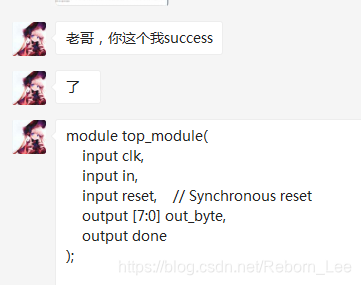本文共 6065 字,大约阅读时间需要 20 分钟。
目录
求助原题
(蓝色字体,即是链接本身)
We want to add parity checking to the serial receiver. Parity checking adds one extra bit after each data byte. We will use odd parity, where the number of 1s in the 9 bits received must be odd. For example, 101001011 satisfies odd parity (there are 5 1s), but 001001011 does not.
Change your FSM and datapath to perform odd parity checking. Assert the done signal only if a byte is correctly received and its parity check passes. Like the , this FSM needs to identify the start bit, wait for all 9 (data and parity) bits, then verify that the stop bit was correct. If the stop bit does not appear when expected, the FSM must wait until it finds a stop bit before attempting to receive the next byte.
You are provided with the following module that can be used to calculate the parity of the input stream (It's a TFF with reset). The intended use is that it should be given the input bit stream, and reset at appropriate times so it counts the number of 1 bits in each byte.
module parity ( input clk, input reset, input in, output odd); always @(posedge clk) if (reset) odd <= 0; else if (in) odd <= ~odd;endmodule
Note that the serial protocol sends the least significant bit first, and the parity bit after the 8 data bits.

我的方案
如何用状态机设计这个电路呢?
求助路过的同行尝试做下这个题?
如果能Success,希望能告知一下,感谢。
我已经把不带奇偶校验的设计给出,如下:
最后给出我的不成功的方案:
状态转移图

我的设计
module top_module( input clk, input in, input reset, // Synchronous reset output [7:0] out_byte, output done); // // Use FSM from Fsm_serial localparam START = 0, B1 = 1, B2 = 2, B3 = 3, B4 = 4, B5 = 5, B6 = 6, B7 = 7, B8 = 8, B9 = 9, STOP = 10, D0 = 11, D1 = 12, D2 = 13; reg [3:0] state, next_state; wire odd; wire en; reg [7:0] out_byte_mid; always@(*) begin case(state) START: begin if(~in) next_state = B1; else next_state = START; end B1: begin next_state = B2; end B2: begin next_state = B3; end B3: begin next_state = B4; end B4: begin next_state = B5; end B5: begin next_state = B6; end B6: begin next_state = B7; end B7: begin next_state = B8; end B8: begin next_state = B9; end B9: begin next_state = STOP; end STOP: begin if(in&&odd) next_state = D0; else if(in&&(~odd)) next_state = D2; else next_state = D1; end D0: begin if(in == 1) next_state = START; else next_state = B1; end D1: begin if(in == 0) next_state = D1; else next_state = START; end D2: begin if(in) next_state = D2; else next_state = B1; end default: begin next_state = START; end endcase end always@(posedge clk) begin if(reset) state <= START; else state <= next_state; end always@(*) begin case(state) START: begin ; end B1: begin out_byte_mid[0] = in; end B2: begin out_byte_mid[1] = in; end B3: begin out_byte_mid[2] = in; end B4: begin out_byte_mid[3] = in; end B5: begin out_byte_mid[4] = in; end B6: begin out_byte_mid[5] = in; end B7: begin out_byte_mid[6] = in; end B8: begin out_byte_mid[7] = in; end B9: begin ; end STOP: begin ; end D0: begin ; end D1: begin ; end D2: begin ; end default: begin ; end endcase end assign done = (state == D0) ? 1 : 0; assign en = (state == B1)||(state == B2)||(state == B3)||(state == B4) ||(state == B5)||(state == B6)||(state == B7)||(state == B8)||(state == B9) ? 1: 0; assign out_byte = done ? out_byte_mid : 8'b0; // New: Add parity checking. parity inst_parity( .clk(clk), .reset(reset), .in(in&en), //.en(en), .odd(odd) );endmodule
等待你的方案?
20200107更新,下面是群里的一位老哥的答案,十分感谢,还没来得及看,先放这里,以免忘记。

module top_module( input clk, input in, input reset, // Synchronous reset output [7:0] out_byte, output done); reg odd; reg[4:0] state,nstate; parameter start=0,d0=1,d1=2,d2=3,d3=4,d4=5,d5=6,d6=7,d7=8,stop=9,done1=10,done2=11,w=13,p=12; always@(*) begin case(state) start:begin if(in==0)nstate=d0;else nstate=start;end d0:begin nstate=d1;out_byte[0]=in;end d1:begin nstate=d2;out_byte[1]=in;end d2:begin nstate=d3;out_byte[2]=in;end d3:begin nstate=d4;out_byte[3]=in;end d4:begin nstate=d5;out_byte[4]=in;end d5:begin nstate=d6;out_byte[5]=in;end d6:begin nstate=d7;out_byte[6]=in;end d7:begin nstate=p;out_byte[7]=in;end p: begin nstate=stop; odd=^out_byte[7:0]^in; end stop: begin if(in==1) nstate=done1;else nstate=w; end done1:begin if(in==1) nstate=start;else nstate=d0; end w:begin if(in==1) nstate=start;else nstate=w; end endcase end always@(posedge clk) begin if(reset==1) state<=start; else state<=nstate; end assign done=(state==done1&&odd)?1:0;endmodule
转载地址:http://adcaf.baihongyu.com/